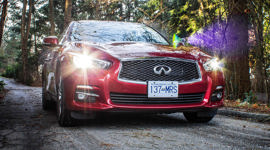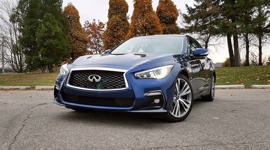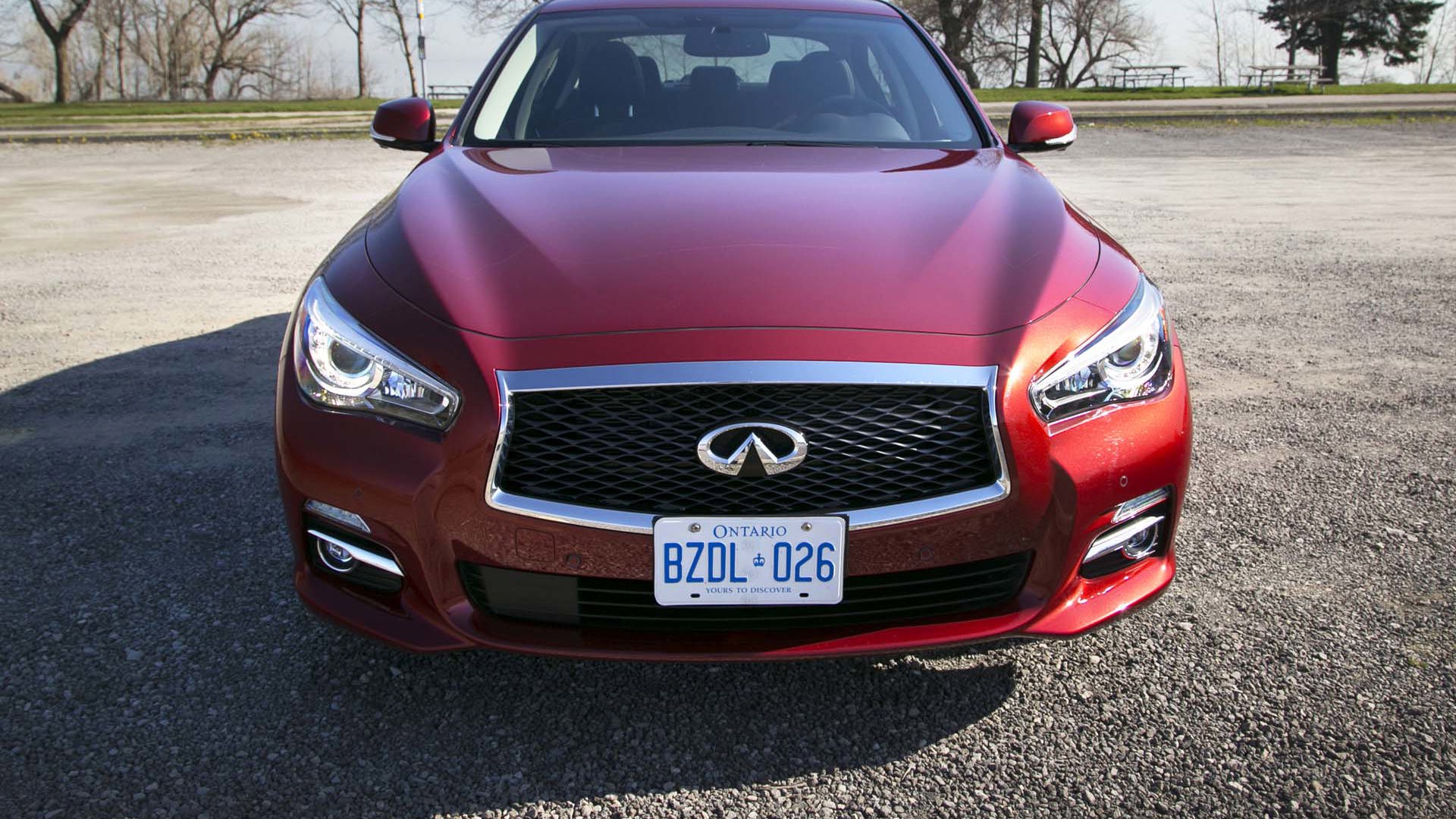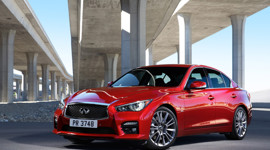To say I was annoyed with myself would be a dramatic understatement. Understeer?! Really? I’m driving a twin-turbo, RWD, V6 sport sedan and I’m scrubbing the fronts two turns into the handling course. Frankly, I’m ashamed of myself. There’s really no need for it.
Luckily, Infiniti has a solution. 400 of them in fact. So I brush the brake to pin the front, take a little less lock out of the steering to lighten the burden and stab the throttle – hard. The back end lights up like Diwali and I’m suddenly chasing the wheel back the other way to arrest what can only be described as a fantastic, extroverted power slide, before pulling to a stop and pretending I did it all on purpose.
Infiniti promises that Red Sport models will always be a step-up in performance over the lower trims, and never just an aesthetic package.
So yeah, the 2016 Infiniti Q50 Red Sport 400 is fun to drive. Well it is in this configuration. We’re in the US, driving the Red Sport the way the US will get them: Rear-wheel drive. Here in the great white north where it snows and insurance companies are winning the information wars the high-po Q50 will only be available in all-wheel drive.
You can expect Red Sport to be Infiniti’s tag for all of its performance models and trims going forward, a’la F Sport for Lexus and S Line for Audi. Infiniti promises that Red Sport models will always be a step-up in performance over the lower trims, and never just an aesthetic package.
Visually the Q50 is unchanged from the first generation, but from this year on two new power trains are coming on. Gone is the award-winning 3.7L V6, in its place a base 2.0T four cylinder derived from Mercedes-Benz and a 3.0L twin-turbo V6. The V6 comes in two configurations broken down into 300 hp and 400 hp editions. There’s also a hybrid which Infiniti is targeting a five-percent take rate for.
The 2.0T will be available in the base trims. It produces 208 hp at 5,500 rpm and 258 lb-ft between 1,500 and 3,500. This is the same engine found in the Mercedes-Benz GLA 250 and in the upcoming Infiniti QX30 series. Fuel economy for the 2.0T is around 10 percent better than the six at 10.6/8.4/9.6 L/100 km city/highway/combined. The V6 is rated at 12.3/8.5/10.6 in 300 hp mode and 12.8/9.1/11.1 for the 400 hp engine. All three engine formats get an all-Infiniti seven-speed automatic gearbox.
Present at our test was the US-spec RWD Red Sport 400 trim in two guises. One, with the Direct Adaptive drive-by-wire steering, the second with the conventional electric steering – though this year with a rack mount instead of column mount.
Infiniti’s new generation of steering promises better road feel and weight than the previous. The base electric steering now employs a rack-mounted servo to boost the steering. It feels lighter than the Direct Adaptive Steering despite having a proper mechanical connection to the front wheels.
Direct Adaptive Steering is a fly-by-wire system that has the steering column in place only as a legislated back-up in case the electric system fails. It is decouple in normal conditions with clutches that kick in if the electric system fails. The system removes the regular bumps and wobbles you’ll experience completely, as demonstrated by a low-speed pass over off-set speed bumps.
With my hands peacefully resting in my lap the steering wheel stays completely still over the bumps, while the steering wheel on the non-DAS car bounces around all over the shop. Personally, I enjoy feeling those bumps and imperfections and thus will always prefer hydraulic steering. Drive-by-wire does open up possibilities not only in terms of autonomous driving but in the future when legislation catches up will also allow for different packaging and layout as well as significant weight savings - the performance gains of which will be wasted on the robots driving our cars for us. Still, the weight reduction will help at the pump.
And credit where it’s due: The DAS has been tuned beautifully. It was very much my favourite of the two systems completely contrary to my expectations. It actually transmits great feel through the wheel and solid feedback. Response is better than the non-steer-by-wire system and the weight is hefty and convincing – far more than the regular electric steering.
Dynamic Digital Suspension allows for three drive modes and individual suspension tuning between comfort and sport. It offers a comfortable (ish) ride on the road and a firmer, more responsive chassis out on the handling course. The electric valve-controlled dampers provide a good range between comfort and sport modes helping give the Q50 a decent compromise out on the highway and enjoyable driving dynamics in the tighter stuff.
The drive modes available range from Snow, Eco, Standard, Sport, Sport+ through to Personal. Sport+ firms up the steering and the suspension, makes for faster shifts, more willing downshifts at higher RPM and improves throttle response. It also dramatically reduces the invasiveness of the traction control and electronic stability control systems.
The technology onslaught doesn’t stop at the engine and suspension components.
In addition to cross-traffic alert, lane keep assist, radar adaptive cruise control and blind-spot detection the Q50 now also supports forward collision prevention (braking) and rear-collision prevention via braking.
We tested both in San Antonio with great success. The forward-collision system actually stopped the car dead at a traffic light in a controlled and stable fashion. It wasn’t abrupt or frightening, it was smooth, progressive and felt natural.
My passenger didn’t believe me when I told her I hadn’t touched the brake at all during the process. She was also unimpressed when she realized it was true. People don’t like it when I experiment.
The brake pedal will be needed to hold the car still once it’s stopped though. Adaptive cruise control was off at the time. I should note that the lane-keeping assist function was flakey on the pre-production models we tested, so I look forward to testing a production model to see if it works better then. In the meantime I was forced to keep the car in its lane by myself – the horror!
You will need to “opt in” to the systems. That means you must turn on the lane-keep assist and radar systems each time you get into the car in order for these features to work. This is a neat way to approach the legislative and personal-injury lawyer minefield of driver safety systems – it puts the onus where it belongs: on the driver. It also mitigates our ability to say “Oh I didn’t know what that is so I turned it off”.
In the interior the Q50 is comfortable and elegant. The glossy wood grain is a bit naff but the aluminium trim is nice. The paddle shifters are genuine magnesium. Where the Red Sport is let down is in the steering wheel and seats. The seats are wonderful and comfortable but hardly sporty or special. Likewise, you get the same basic steering wheel no matter which Q50 you select.
F Sport and M cars and even Audi’s S Line cars get ultra-sexy steering wheels with meaty thick rims, heavy leather and even flat bottoms. The sort of wheel you grab hold of and sigh a deep sigh of joy. The Q50 wheel feels the same in all guises – and it shouldn’t. Because the Q50 in 400 hp mode feels spectacular.
Wind noise and road noise are extremely muted which is pleasing, but I missed hearing the engine noise especially given Infiniti’s noted V6 growl. At least they haven’t piped fake engine noise in to balance it.
The balance of the chassis is set 54:46 front:rear, the engineers tell me this is for better balance under acceleration and also to free up the back – it definitely does that. Transferring understeer into oversteer is effortless, and the Q50 responds willingly to mid-corner corrections. You can move the car around underneath you with surprising ease – making muppets like me feel like the racing drivers we wish we could have been.
The new engines open up trim options for the Q50. Infiniti says the Q50 is now a much more rounded offering.
| Warranty: 4 years/100,000 km; 6 years/110,000 km powertrain; 7 years/unlimited distance corrosion perforation; 4 years/100,000 km roadside assistance Competitors: |
The first is the Base trim available only with the 2.0T and equipped with a sun roof and heated front seats. Next level is the Premium trim which adds leather, navigation, Bose audio and the convenience package. It also adds the availability of the 300 hp 3.0L V6.
The Driver Assistance Package can be added to the 2.0T to max out that package, but the trims keep climbing for V6 models.
The Technology package adds 19-inch wheels, wood grain, and the raft of driving aid technologies. Nestled between those trims is the Sport trims which in Sport Premium, Sport Driver Assistance Package and Sport Technology.
Red Sport 400 models are available in Sport Driver Assistance Package and Sport Technology trims only. The Hybrid model is available in only the fully loaded Technology trim.
Pricing has not yet been announced, but the Q50 comes on sale in early spring































































